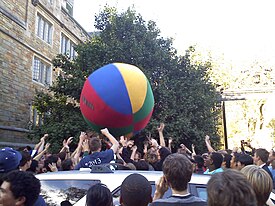
Yale University is a private Ivy League research university in New Haven, Connecticut. Founded in 1701, Yale is the third-oldest institution of higher education in the United States, and one of the nine colonial colleges chartered before the American Revolution.

New Haven is a city in New Haven County, Connecticut, United States. It is located on New Haven Harbor on the northern shore of Long Island Sound and is part of the New York City metropolitan area. With a population of 135,081 as determined by the 2020 U.S. census, New Haven is the third largest city in Connecticut after Bridgeport and Stamford, the largest city in the South Central Connecticut Planning Region, and the principal municipality of Greater New Haven, which had a total population of 864,835 in 2020. Prior to 1960, it was the county seat of New Haven County until the county governments were abolished that year.
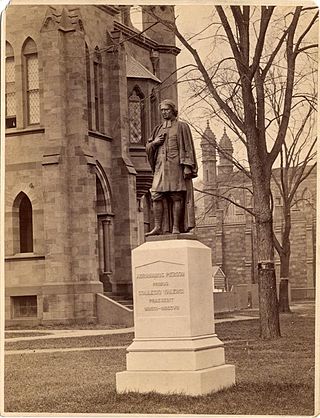
Abraham Pierson was an American Congregational minister who served as the first rector, from 1701 to 1707, and one of the founders of the Collegiate School — which later became Yale University.

Yale College is the undergraduate college of Yale University. Founded in 1701, it is the original school of the university. Although other Yale schools were founded as early as 1810, all of Yale was officially known as Yale College until 1887, when its schools were confederated and the institution was renamed Yale University.
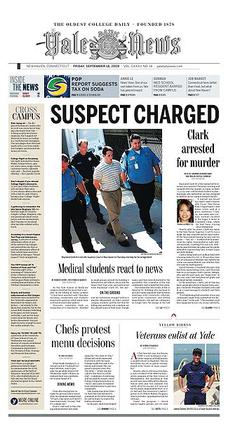
The Yale Daily News is an independent student newspaper published by Yale University students in New Haven, Connecticut since January 28, 1878. It is the oldest college daily newspaper in the United States. The Yale Daily News has consistently been ranked among the top college daily newspapers in the country.

Saybrook College is one of the 14 residential colleges at Yale University.
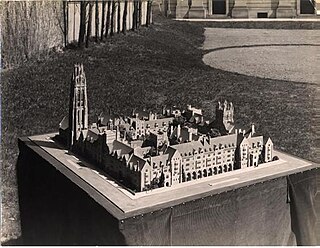
The Memorial Quadrangle is a residential quadrangle at Yale University in New Haven, Connecticut. Commissioned in 1917 to supply much-needed student housing for Yale College, it was Yale's first Collegiate Gothic building and its first project by James Gamble Rogers, who later designed ten other major buildings for the university. The Quadrangle has been occupied by Saybrook College and Branford College, two of the original ten residential colleges at Yale. The collegiate system of Yale University was largely inspired by the Oxbridge model of residential and teaching colleges at the University of Oxford and the University of Cambridge in the UK.

Branford College is one of the 14 residential colleges at Yale University.
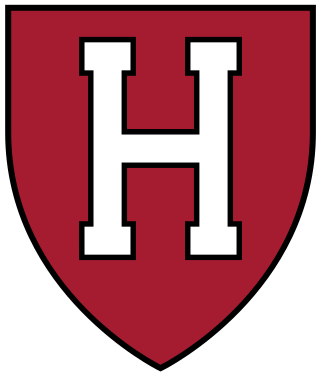
The Harvard–Yale football rivalry is renewed annually with The Game, an American college football match between the Harvard Crimson football team of Harvard University and the Yale Bulldogs football team of Yale University.
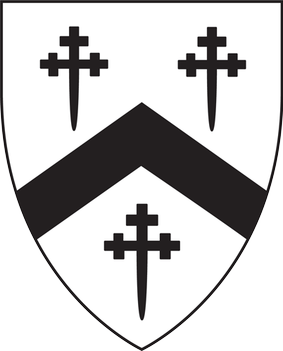
Davenport College is one of the fourteen residential colleges of Yale University. Its buildings were completed in 1933 mainly in the Georgian style but with a gothic façade along York Street. The college was named for John Davenport, who founded Yale's home city of New Haven, Connecticut. An extensive renovation of the college's buildings occurred during the 2004–2005 academic year as part of Yale's comprehensive building renovation project. Davenport College has an unofficial rivalry with adjoining Pierson College.
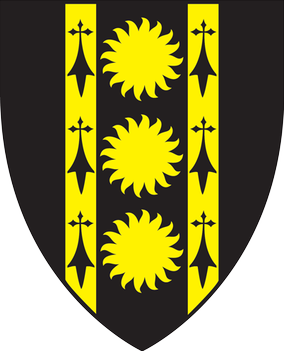
Pierson College is a residential college at Yale University in New Haven, Connecticut. Opened in 1933, it is named for Abraham Pierson, a founder and the first rector of the Collegiate School, the college later known as Yale. With just under 500 undergraduate members, Pierson is the largest of Yale's residential colleges by number of students.

Jonathan Edwards College is a residential college at Yale University. It is named for theologian and minister Jonathan Edwards, a 1720 graduate of Yale College. JE's residential quadrangle was the first to be completed in Yale's residential college system, and was opened to undergraduates in 1933.

The Old Campus is the oldest area of the Yale University campus in New Haven, Connecticut. It is the principal residence of Yale College freshmen and also contains offices for the academic departments of Classics, English, History, Comparative Literature, and Philosophy. Fourteen buildings—including eight dormitories and two chapels—surround a 4-acre (1.6 ha) courtyard with a main entrance from the New Haven Green known as Phelps Gate.
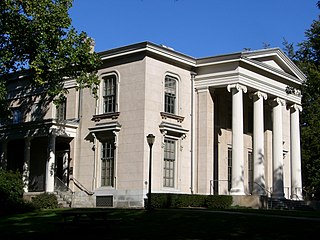
Hillhouse Avenue is a street in New Haven, Connecticut, famous for its many nineteenth century mansions, including the president's house at Yale University. Both Charles Dickens and Mark Twain have described it as "the most beautiful street in America." Much of the avenue is included in the Hillhouse Avenue Historic District, which extends to include houses on adjacent streets.
WYBC is a radio station operating on the campus of Yale University in New Haven, Connecticut. The station is owned by Yale Broadcasting Company, Inc.; however, it is programmed by Sacred Heart University under a time brokerage agreement. WYBC is a public radio station, airing a news/talk format.

William Charles Wurtenburg was an American college football player and coach. Born and raised in Western New York to German parents, Wurtenburg attended the prestigious Phillips Exeter Academy, where he played football. He enrolled in classes at Yale University in 1886 and soon earned a spot on the school's football team. He played for Yale from 1886 through 1889, and again in 1891; two of those teams were later recognized as national champions. His 35-yard run in a close game in 1887 against rival Harvard earned him some fame. Wurtenburg received his medical degree from Yale's Sheffield Scientific School in 1893.
The 1870 college football season is regarded as the second United States intercollegiate football season. The season involved only three teams and two known games which took place in November 1870. As in 1869, the season's two games occurred about fifteen miles apart in New Brunswick and in Princeton, New Jersey.
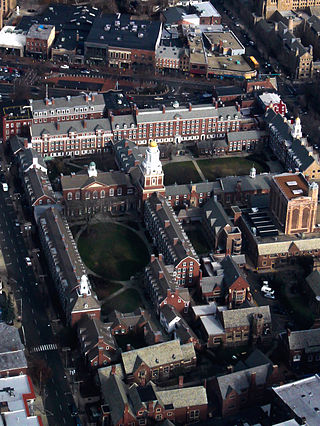
Yale University has a system of fourteen residential colleges with which all Yale undergraduate students and many faculty are affiliated. Inaugurated in 1933, the college system is considered the defining feature of undergraduate life at Yale College, and the residential colleges serve as the residence halls and social hubs for most undergraduates. Construction and programming for eight of the original ten colleges were funded by educational philanthropist Edward S. Harkness. Yale was, along with Harvard, one of the first universities in the United States to establish a residential college system.
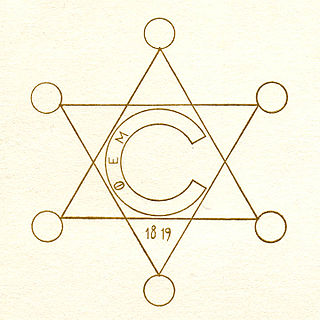
The Calliopean Society, also known as the Fraternity of Phi Epsilon Mu, is a literary and debating society at Yale College founded in 1819, disbanded in 1853, and revived in 1950. Its name refers to Calliope, chief of the muses and muse of epic poetry, daughter of Zeus and Mnemosyne (memory).
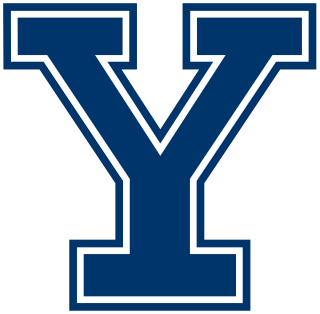
The 1913–14 Yale Bulldogs men's ice hockey season was the 19th season of play for the program.
